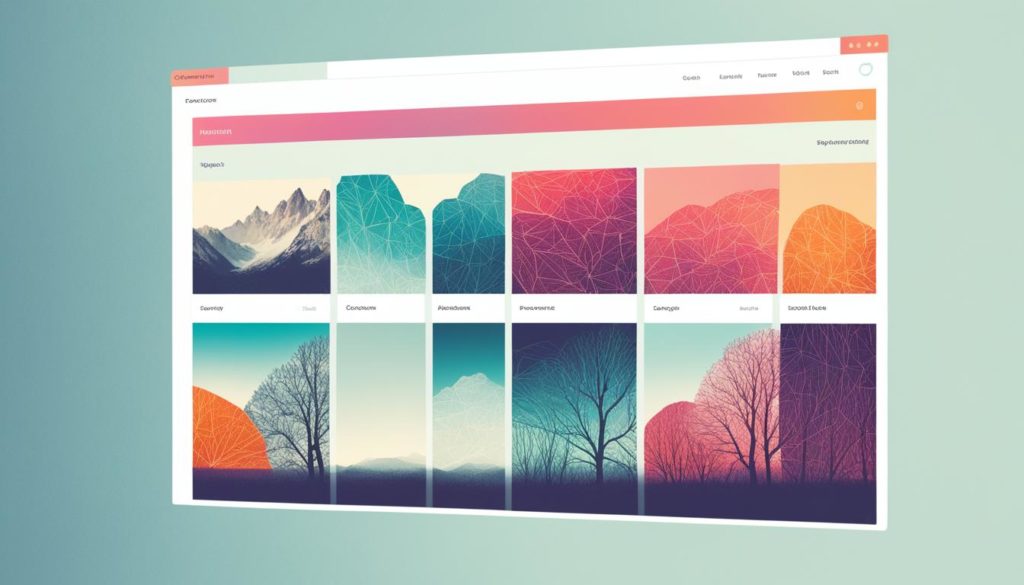
Did you know more than 80.3% of developers use Bootstrap? That’s not shocking. Bootstrap is in 18.6% of websites globally and has a big community backing. CSS frameworks are key in web development, letting us build responsive, modern sites quickly. In 2024, Bootstrap, Tailwind CSS, Bulma, Semantic UI, Foundation, and Materialize lead. Each offers special features for speed and ease, enhancing web development.
These tools save developers the trouble of starting from zero, helping them create responsive designs fast. The tech scene moves forward, and these frameworks evolve, achieving new milestones. Bootstrap shines, used in projects by giants like Spotify, Twitter, and Udemy. These frameworks are crucial. Tailwind CSS has a tough learning curve but keeps 75.5% of its developers, says the 2023 State of CSS survey. Let’s look closer at these options for your next project.
Key Takeaways
- Bootstrap is top with lots of users and a big community.
- Tailwind CSS keeps developers happy, even if it’s hard to learn.
- Bulma is easy to use but has fewer followers.
- Semantic UI might slow down sites with its big files but is powerful.
- Foundation focuses on mobile-first design, ideal for responsive projects.
Want to know more about these modern CSS frameworks? Stay with us as we detail each framework and their unique qualities in 2023.
Introduction to CSS Frameworks
CSS frameworks are key in web development today. They make styling and building web pages faster by offering ready-made code. This code helps with design and layout, making things less complicated. Languages like JavaScript support these frameworks to tackle design issues easily.
What are CSS Frameworks?
CSS frameworks give developers ready-to-use CSS codes and parts. This helps in designing websites quickly. Instead of starting from zero, we use these frameworks. Bootstrap and Foundation are examples with many features that speed up web work.
Why Developers Use CSS Frameworks?
There are good reasons for choosing CSS frameworks. For one, they speed up the making of nice layouts. They also let us change designs easily for any project. And, they make repetitive tasks simpler and keep web pages consistent.
Key Benefits of CSS Frameworks
Using CSS frameworks offers many benefits that improve our work:
- Consistent Designs: They keep the look of all pages uniform, which helps with brand image.
- Responsive Grids: Their grid systems adjust layouts to fit different screens smoothly.
- Pre-configured Styles: We get components like buttons already styled, which saves time.
By adding CSS frameworks to our tools, we can make sleek, professional sites more easily and quickly. Choosing to use popular frameworks means we get to take advantage of their built-in expertise. This makes our development experience better and more fun.
Top Contenders: Bootstrap, Tailwind CSS, Bulma, Semantic UI, and Foundation
For developers looking at top CSS frameworks, there are five key options. Each framework has something special for different projects. Let’s take a closer look at what they offer and their pros and cons.
Bootstrap: A Reliable Choice for All Projects
Bootstrap stands out for its flexibility and strong community support. It’s great for anyone, from beginners to pros. You can count on it for any type of project.
Pros and Cons of Using Bootstrap
| Pros | Cons |
|---|---|
| Extensive documentation and community support | Large file size |
| Comprehensive range of components | Can be overwhelming for small projects |
| Highly customizable | Needs extra work for unique looks |
Tailwind CSS: Utility-First Approach
Tailwind CSS is all about speed and customization. It uses utility classes in HTML for a streamlined process. It’s a favorite for its lightweight nature and speed in development.
Advantages and Disadvantages of Tailwind CSS
| Advantages | Disadvantages |
|---|---|
| Faster development with utility-classes | Harder to learn for starters |
| Highly customizable | Can make HTML messy |
| Small file size | Needs a grasp of its configurations |
Bulma: Simplicity and Flexibility
Bulma offers a mix of simplicity and flexibility. Its easy syntax and small file size draw many developers. It’s great for efficient and stylish designs.
Pros and Cons of Bulma
| Pros | Cons |
|---|---|
| Simple and intuitive syntax | Fewer components than others |
| Light and quick | Not much community help |
| Responsive from the start | Customizing can be tough |
Semantic UI: Natural Language Principles
Semantic UI is unique for using natural language. This makes coding more readable and user-friendly. It’s a hit for making teamwork and development smoother.
Foundation: Advanced Responsive Framework
Foundation stands out with its mobile-first design. It offers lots of customization and is very flexible. It’s among the top choices for advanced CSS frameworks.
Features and Drawbacks of Foundation
| Features | Drawbacks |
|---|---|
| Mobile-first approach | Tricky to learn initially |
| Plenty of customization | Not so easy for beginners |
| Loads of tools | Bigger file size |
Best CSS frameworks
The best CSS frameworks help developers use modern web design ideas to build responsive, efficient interfaces. Frameworks like Bootstrap, Tailwind CSS, and Foundation are famous for their strong features and popularity. With Bootstrap having more than a hundred thousand GitHub stars, it’s a top choice for making websites mobile-friendly and responsive.
Tailwind CSS is the second most popular according to the State of CSS 2023 survey, with about 76% usage. Its utility-first method lets developers style with utility classes, cutting down extra code and boosting customization. This approach makes Tailwind a highly efficient option. It also includes PurgeCSS optimization to reduce file size and ease responsive design tasks.
Foundation is known as a highly advanced responsive framework. It comes with a modular toolkit and learning resources. It has unique UI components like responsive images, pricing tables, and form validation. This makes it great for the latest projects.
CSS frameworks save developers time because they don’t have to start from zero. They improve teamwork and upkeep thanks to detailed libraries and clear rules. They help make sure every part and page looks good and works well together. Companies like OpenAI, Spotify, and GitHub use these tools to make their projects scalable, easy to maintain, and visually up-to-date.
| Framework | Purpose | Strengths |
|---|---|---|
| Bootstrap | Creating mobile-first websites with responsive design | Popular, well-documented, large community |
| Tailwind CSS | Utility-first styling with extensive customization | High optimization, active community, cohesive design |
| Foundation | Advanced responsive design with modular toolkit | Flexible, comprehensive components, training options |
Frameworks like the ones mentioned use pre-built UI components for fast setup, while utility-first frameworks give detailed styles and classes. Despite their differences, they serve various needs and focus on keeping websites fast and scalable. For more information on efficient CSS frameworks, check out modern CSS frameworks.
Unique Choices Gaining Popularity: Materialize, Open Props, and Skeleton
In the evolving CSS framework landscape, Materialize, Open Props, and Skeleton shine. They are lightweight and suited for various web projects.
Materialize CSS is notable for its Google Material Design. This gives a polished look to user interfaces. Launched in September 2011, it has 38k stars and 4.9k forks on GitHub. It is backed by a community of 515 contributors.
Open Props offers easy customization with CSS variables. This allows for quick tweaks to components. It is recognized for its innovation and flexibility in web styling.
Skeleton is prized for its simplicity, providing just what’s needed for smaller projects. It ensures creative freedom and rapid load times. For more details, check out this post on innovative CSS frameworks.
| Framework | Release Date | Github Stats | Mentions | Licenses | Number of Sites | Companies Using |
|---|---|---|---|---|---|---|
| Materialize CSS | September 2011 | 38k Stars, 4.9k Forks, 515 Contributors | 3.2k | MIT | 111,481 | Avhana Health, Mid Day, Architonic |
| Open Props | – | – | – | – | – | – |
| Skeleton | – | – | – | – | – | – |
These CSS frameworks stand out for their performance and efficiency. As design needs become more specific, Materialize, Open Props, and Skeleton will be more valuable. For deeper insights, explore this informative resource.
Conclusion
CSS frameworks are key for today’s web building. They help us make sites that look good, work well on any device, and load fast. Bootstrap is a top pick, thanks to its big support community. Developers love how engaged and helpful users are.
Tailwind CSS is known for speed and letting you customize everything. It’s great because it puts what you need first. This boosts work speed and makes sites easy to use. Meanwhile, Foundation is good for projects that need quick load times and lots of custom touches.
New frameworks like Open Props and Skeleton offer exciting designs and simple use. Some, like Bulma, may lack a big support network. Yet, their focus on building for mobile devices first wins over many developers. Choosing from the best CSS frameworks in 2023 is about finding the right tools for your project.
FAQ
What are CSS Frameworks?
CSS frameworks are tools with ready-made CSS code. They help developers quickly style webpages. They make web design easier and support modern, responsive designs.
Why do developers use CSS frameworks?
Developers use them for faster website building and consistent looks. They make web pages work well on different devices. And they save time by providing pre-built design elements.
What are the key benefits of using CSS frameworks?
They speed up design work and make styles consistent. With them, websites adjust to screen sizes easily. They also come with styles all set to use, helping focus on the site’s look.
What makes Bootstrap a reliable choice for all projects?
Bootstrap is flexible and has a wide user base. It offers many components for easy webpage building. This makes it a favorite for developers.
What are the pros and cons of using Tailwind CSS?
Tailwind CSS allows for quick custom designs. But, it’s harder to learn for new developers.
How does Bulma stand out in terms of simplicity and flexibility?
Bulma’s easy to use and lightweight. It’s great for creating clean, responsive websites without hassle.
What features distinguish Semantic UI from other frameworks?
Semantic UI is all about intuitive development. It offers a wide variety of components. Its focus on readability and ease of use makes it stand out.
Why is Foundation considered an advanced responsive framework?
Foundation is built for mobile-first and customizable designs. Its advanced features suit complex, high-performance websites.
What are some unique and lightweight CSS frameworks gaining popularity?
Materialize, Open Props, and Skeleton stand out for their qualities. Materialize follows Google’s Material Design. Open Props offers customizable options with CSS variables. Skeleton is great for small projects, with its minimalist design.
Future App Studios is an award-winning software development & outsourcing company. Our team of experts is ready to craft the solution your company needs.










